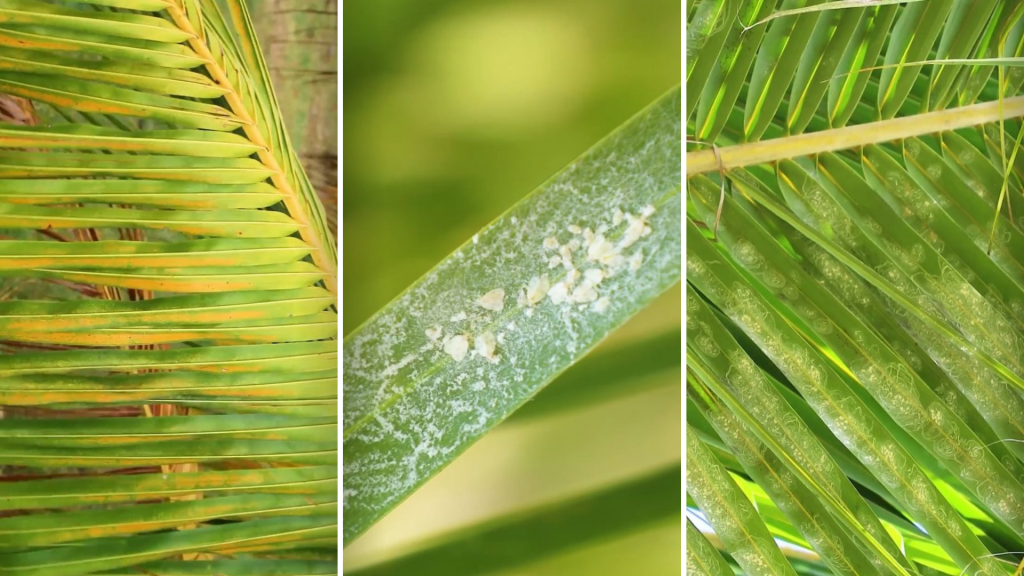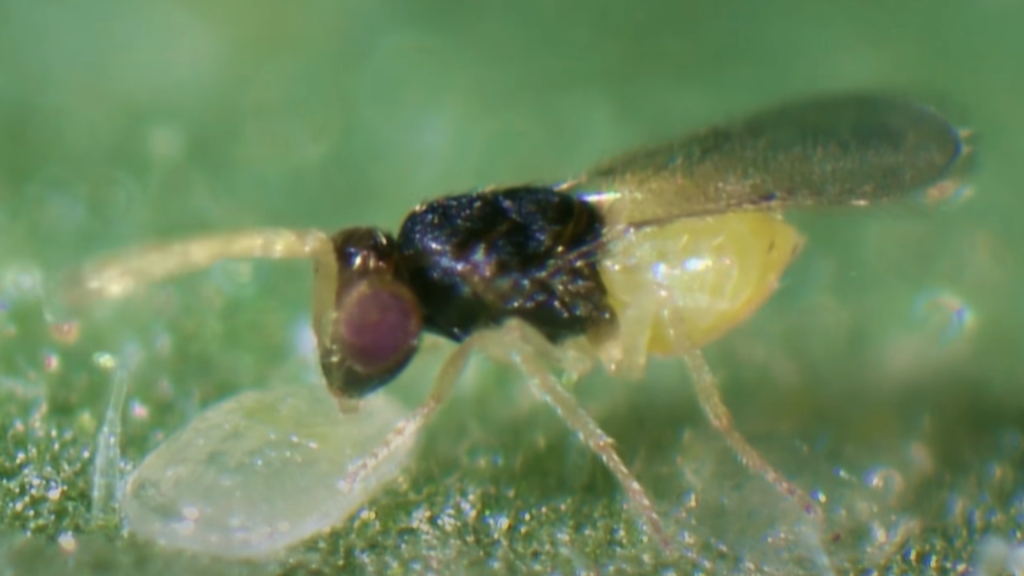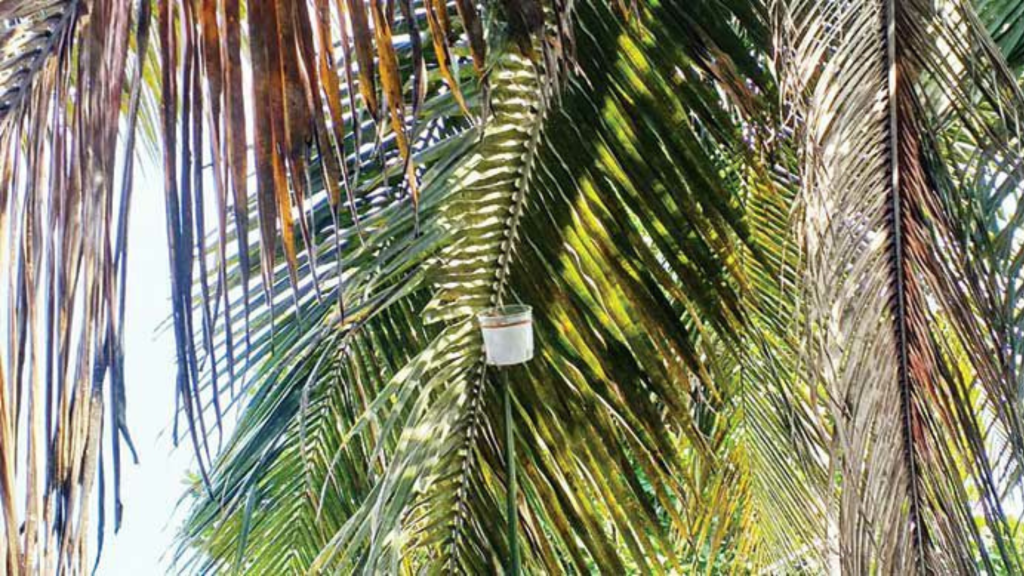Biologically, parasitism and predation are were widely used as natural pest control methods. The researchers focused on applying these control methods to the damage by of the white fly currently spreading around coconuts threatening to develop into an epidemic and cause severe damage. It has been shown through research reports published by foreign countries and even our neighbour India that there are several parasites to control this epidemic.
In this way, not only coconut cultivation but also vegetable crops such as okra, beans, potatoes, tomatoes, eggplants, and chillies are also affected by diverse whiteflies species.
Recently, the control of the coconut whitefly, “Aleurodicus cocois”, which has caused severe damage to coconut plantations and intercrops, has become essential. To control this, as we (were) informed earlier, fumigation (with the help of neem leaves, Holy basil leaves, “Croton Caudatus Geisel” or Kappetiya leaves and discarded tires), installation of whitefly traps, application of chemicals such as sprays, soap liquid, neem oil-soap mixture or thiamethoxam and other traditional methods correctly within a time frame, could be used.

The parasite of Coconut Whitefly
Scientifically named Encarsia Guadeloupe, this parasite was first discovered in the Caribbean islands. This insect is a solitary endoparasite that belongs to Class Hymenoptera and Family Aphelinidea. This insect, which lives in the natural ecosystem of Sri Lanka, is about the size of a tiny wasp. The adult stage of this parasite damages the larval stage of the whitefly. Here, the parasite sucks the essence of the whitefly, which is mainly in the second larval stage and lays its eggs on it. As a result, the parasite population grows, and the whitefly population decreases over time.
These parasites already naturally inhabit the coconut plants that the whitefly damages, so pest control can also occur naturally. But due to the rapid increase in current pest density and the time it takes for parasites to develop naturally and become parasitized, the artificial release of parasites has become necessary. Currently, chemical methods have adversely affected the population growth of naturally occurring parasites.

A few conditions
• This method is successful for a coconut tree with 50 per cent whiteflies. Otherwise, farmers should treat plants with the higher pest population with a pressurized water jet or control methods such as a neem oil mixture. The main reason is that if the number of parasitoids surpasses the optimal level relative to the pest population, the parasitism process cannot occur as expected.
• Attention should be paid to consider environmental factors such as temperature and rainfall before releasing parasites into the field. Researchers have shown that parasitism is reduced when the average temperature exceeds 30oC and annual rainfall is above average.
• Parasites are now known to cause damage only to larval stages of whitefly. Parasites prefer the immobile 2nd instar of the whitefly larval stages. Because of this, simply releasing the parasites into the tree will not reduce the whitefly population, and it will take some time for the parasitism to develop.
The hope
The Coconut Research Institute and the Gannoruwa Agricultural Research Institute recently recommended Encarsia Guadeloupe as a long-term method to control the whitefly parasite. In this way, they have found a parasitic species called Eretmocerus cremicus to control the white fly species that live in vegetables. Meanwhile, they are currently breeding and testing this parasite. And they are conducting research and experiments in the initial stage of releasing parasites to areas like Panadura, Kolonnawa, Rathmalana and Ganemulla in the Western Province, where this pest damage is most common. Researchers say a single whitefly-infested coconut tree releases about 500 artificially bred parasites. Currently, according to the information given to us by them, the results are at a successful level.

But our suggestion is not to wait for these biological methods but to adopt at least one recommended pest control method in order to reduce the damage of by these insects. It will also aid in releasing future parasites and the success of natural parasitism. Additional information regarding the acquisition and release of bred parasites is available from the Agricultural Research Institute, and we hope to update relevant information subject to institutional recommendations in due course.
References
G. Mollot, N. Borowiec, P.F. Duyck, S. Glenac, and S. Quilici. 2015. “Life-history traits of Encarsia guadeloupae, a natural enemy of the invasive spiralling whitefly Aleurodicus dispersus.” Applied Entomology 209-217.
K. Elango, and S. Jeyarajan Nelson. 2020. “Influence of intercrops in Coconut on Encarsia guadeloupae Viggiani parasitization of Rugose Spiralling Whitefly leurodicus rugioperculatus Martin.” Annals of Plant Protection Sciences 1-3.
K. SELVARAJ, ANKITA GUPTA, T. VENKATESAN, S. K. JALALI, R. SUNDARARAJ, and CHANDISH R. BALLAL. 2017. “First record of invasive rugose spiraling whitefly Aleurodicus rugioperculatus Martin (Hemiptera: Aleyrodidae) along with parasitoids in Karnataka.” Journal of Biological Control 1-5.
“Potential invasive pests of agricultural crops.” By I. Stocks. J. E. Peña. Accessed 2023. https://www.cabidigitallibrary.org/.


Leave a Reply